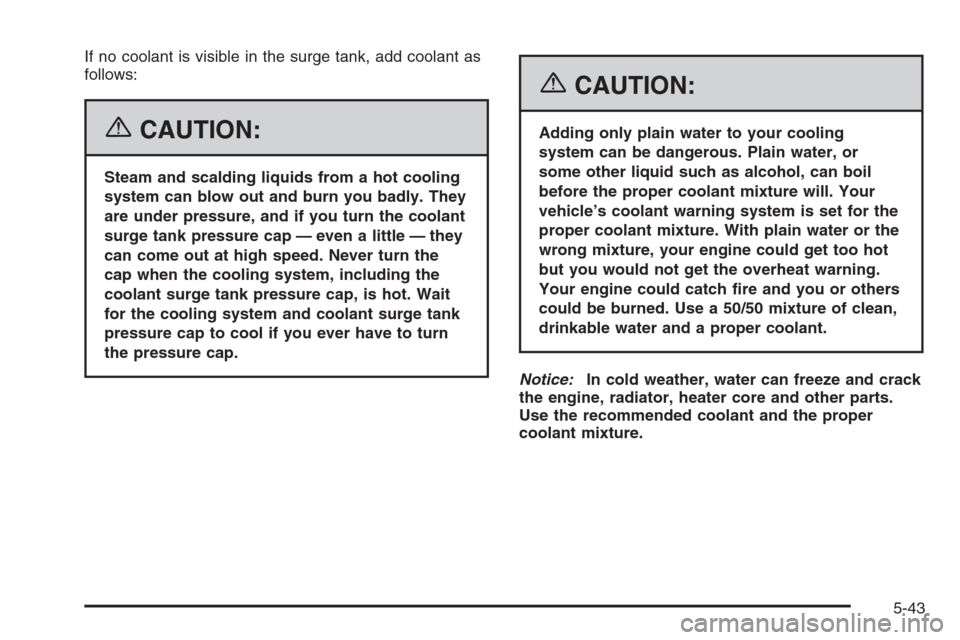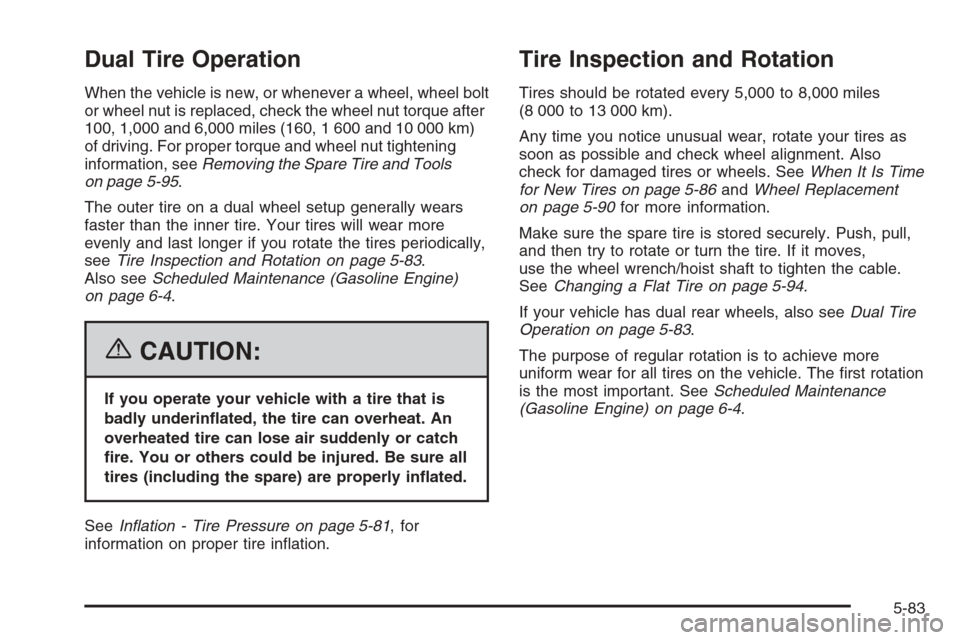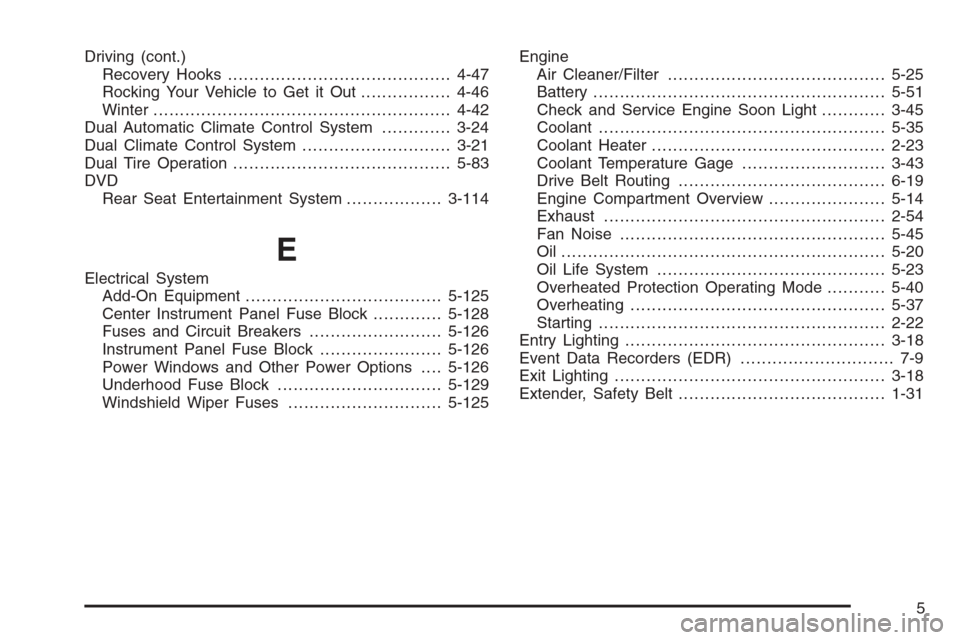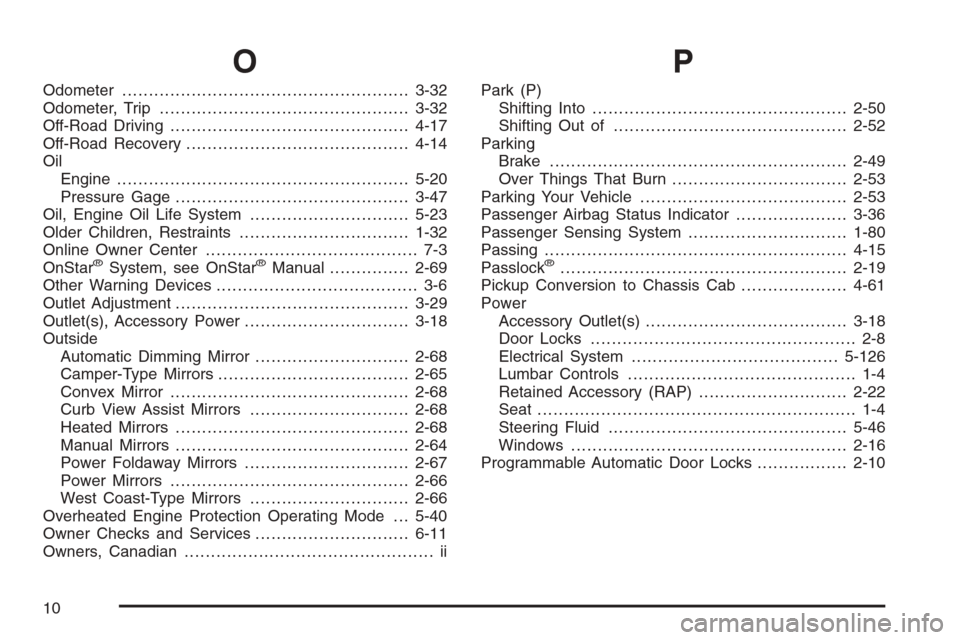2006 CHEVROLET SILVERADO engine overheat
[x] Cancel search: engine overheatPage 447 of 594

If no coolant is visible in the surge tank, add coolant as
follows:
{CAUTION:
Steam and scalding liquids from a hot cooling
system can blow out and burn you badly. They
are under pressure, and if you turn the coolant
surge tank pressure cap — even a little — they
can come out at high speed. Never turn the
cap when the cooling system, including the
coolant surge tank pressure cap, is hot. Wait
for the cooling system and coolant surge tank
pressure cap to cool if you ever have to turn
the pressure cap.
{CAUTION:
Adding only plain water to your cooling
system can be dangerous. Plain water, or
some other liquid such as alcohol, can boil
before the proper coolant mixture will. Your
vehicle’s coolant warning system is set for the
proper coolant mixture. With plain water or the
wrong mixture, your engine could get too hot
but you would not get the overheat warning.
Your engine could catch �re and you or others
could be burned. Use a 50/50 mixture of clean,
drinkable water and a proper coolant.
Notice:In cold weather, water can freeze and crack
the engine, radiator, heater core and other parts.
Use the recommended coolant and the proper
coolant mixture.
5-43
Page 487 of 594

Dual Tire Operation
When the vehicle is new, or whenever a wheel, wheel bolt
or wheel nut is replaced, check the wheel nut torque after
100, 1,000 and 6,000 miles (160, 1 600 and 10 000 km)
of driving. For proper torque and wheel nut tightening
information, seeRemoving the Spare Tire and Tools
on page 5-95.
The outer tire on a dual wheel setup generally wears
faster than the inner tire. Your tires will wear more
evenly and last longer if you rotate the tires periodically,
seeTire Inspection and Rotation on page 5-83.
Also seeScheduled Maintenance (Gasoline Engine)
on page 6-4.
{CAUTION:
If you operate your vehicle with a tire that is
badly underin�ated, the tire can overheat. An
overheated tire can lose air suddenly or catch
�re. You or others could be injured. Be sure all
tires (including the spare) are properly in�ated.
SeeIn�ation - Tire Pressure on page 5-81, for
information on proper tire in�ation.
Tire Inspection and Rotation
Tires should be rotated every 5,000 to 8,000 miles
(8 000 to 13 000 km).
Any time you notice unusual wear, rotate your tires as
soon as possible and check wheel alignment. Also
check for damaged tires or wheels. SeeWhen It Is Time
for New Tires on page 5-86andWheel Replacement
on page 5-90for more information.
Make sure the spare tire is stored securely. Push, pull,
and then try to rotate or turn the tire. If it moves,
use the wheel wrench/hoist shaft to tighten the cable.
SeeChanging a Flat Tire on page 5-94.
If your vehicle has dual rear wheels, also seeDual Tire
Operation on page 5-83.
The purpose of regular rotation is to achieve more
uniform wear for all tires on the vehicle. The �rst rotation
is the most important. SeeScheduled Maintenance
(Gasoline Engine) on page 6-4.
5-83
Page 529 of 594

Engine Identi�cation
The eighth character in the VIN is the engine code.
This code will help you identify your vehicle’s engine,
speci�cations, and replacement parts.
Service Parts Identi�cation Label
You will �nd this label on the inside of the glove box.
It is very helpful if you ever need to order parts.
On this label, you will �nd the following:
VIN
Model designation
Paint information
Production options and special equipment
Do not remove this label from the vehicle.
Electrical System
Add-On Electrical Equipment
Notice:Don’t add anything electrical to your vehicle
unless you check with your dealer �rst. Some
electrical equipment can damage your vehicle and
the damage wouldn’t be covered by your warranty.
Some add-on electrical equipment can keep other
components from working as they should.
Your vehicle has an airbag system. Before attempting
to add anything electrical to your vehicle, seeServicing
Your Airbag-Equipped Vehicle on page 1-86.
Windshield Wiper Fuses
The windshield wiper motor is protected by an internal
circuit breaker and a fuse. If the motor overheats due to
heavy snow, etc., the wiper will stop until the motor
cools. If the overload is caused by some electrical
problem and not snow, etc., be sure to get it �xed.
5-125
Page 583 of 594

Driving (cont.)
Recovery Hooks..........................................4-47
Rocking Your Vehicle to Get it Out.................4-46
Winter........................................................4-42
Dual Automatic Climate Control System.............3-24
Dual Climate Control System............................3-21
Dual Tire Operation.........................................5-83
DVD
Rear Seat Entertainment System..................3-114
E
Electrical System
Add-On Equipment.....................................5-125
Center Instrument Panel Fuse Block.............5-128
Fuses and Circuit Breakers.........................5-126
Instrument Panel Fuse Block.......................5-126
Power Windows and Other Power Options....5-126
Underhood Fuse Block...............................5-129
Windshield Wiper Fuses.............................5-125Engine
Air Cleaner/Filter.........................................5-25
Battery.......................................................5-51
Check and Service Engine Soon Light............3-45
Coolant......................................................5-35
Coolant Heater............................................2-23
Coolant Temperature Gage...........................3-43
Drive Belt Routing.......................................6-19
Engine Compartment Overview......................5-14
Exhaust.....................................................2-54
Fan Noise..................................................5-45
Oil .............................................................5-20
Oil Life System...........................................5-23
Overheated Protection Operating Mode...........5-40
Overheating................................................5-37
Starting......................................................2-22
Entry Lighting.................................................3-18
Event Data Recorders (EDR)............................. 7-9
Exit Lighting...................................................3-18
Extender, Safety Belt.......................................1-31
5
Page 588 of 594

O
Odometer......................................................3-32
Odometer, Trip...............................................3-32
Off-Road Driving.............................................4-17
Off-Road Recovery..........................................4-14
Oil
Engine.......................................................5-20
Pressure Gage............................................3-47
Oil, Engine Oil Life System..............................5-23
Older Children, Restraints................................1-32
Online Owner Center........................................ 7-3
OnStar
®System, see OnStar®Manual...............2-69
Other Warning Devices...................................... 3-6
Outlet Adjustment............................................3-29
Outlet(s), Accessory Power...............................3-18
Outside
Automatic Dimming Mirror.............................2-68
Camper-Type Mirrors....................................2-65
Convex Mirror.............................................2-68
Curb View Assist Mirrors..............................2-68
Heated Mirrors............................................2-68
Manual Mirrors............................................2-64
Power Foldaway Mirrors...............................2-67
Power Mirrors.............................................2-66
West Coast-Type Mirrors..............................2-66
Overheated Engine Protection Operating Mode . . . 5-40
Owner Checks and Services.............................6-11
Owners, Canadian............................................... ii
P
Park (P)
Shifting Into................................................2-50
Shifting Out of............................................2-52
Parking
Brake........................................................2-49
Over Things That Burn.................................2-53
Parking Your Vehicle.......................................2-53
Passenger Airbag Status Indicator.....................3-36
Passenger Sensing System..............................1-80
Passing.........................................................4-15
Passlock
®......................................................2-19
Pickup Conversion to Chassis Cab....................4-61
Power
Accessory Outlet(s)......................................3-18
Door Locks.................................................. 2-8
Electrical System.......................................5-126
Lumbar Controls........................................... 1-4
Retained Accessory (RAP)............................2-22
Seat............................................................ 1-4
Steering Fluid.............................................5-46
Windows....................................................2-16
Programmable Automatic Door Locks.................2-10
10